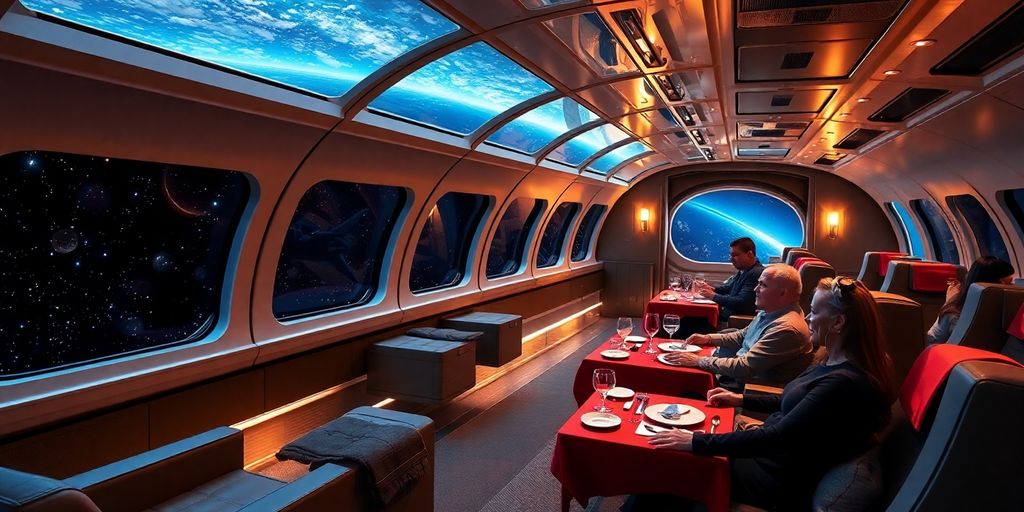Space tourism is no longer just a dream; it’s becoming a reality, and companies are working hard to make it as luxurious and comfortable as possible. With innovations in wellness, dining, and accommodations, travelers can expect a unique experience that combines adventure with the comforts of high-end living. As we look to the stars, let’s explore how these companies are transforming space travel into a lavish getaway.
Key Takeaways
- Space tourism is evolving with a focus on wellness solutions for travelers.
- Luxury accommodations are being designed to offer comfort and unique experiences in orbit.
- Gourmet dining is becoming a highlight of space travel, featuring meals from top chefs.
- Adventurous activities like spacewalks and zero-gravity sports are on the itinerary.
- Sustainability is key, with companies working to reduce space debris and create eco-friendly travel options.
Innovative Space Travel Wellness Solutions
Space travel is no longer just about getting from point A to point B; it’s about the journey and, more importantly, the well-being of the space traveler. Companies are now focusing on integrating wellness solutions into space travel to ensure passengers remain healthy and comfortable during their time among the stars. It’s not just about surviving; it’s about thriving in space. innovative solutions are key to making this a reality.
Personalized Health Monitoring
Imagine having a personal health assistant constantly monitoring your vitals in space. That’s the idea behind personalized health monitoring. These systems use advanced sensors and AI to track everything from heart rate and sleep patterns to stress levels and radiation exposure. The data collected helps doctors and mission control tailor interventions to keep each traveler in optimal condition. It’s like having a check-up, but all the time. This is especially important for long-duration space stays.
Stress Reduction Techniques
Being confined in a spacecraft, far from Earth, can be stressful. To combat this, space tourism companies are incorporating various stress reduction techniques. These include:
- Meditation and mindfulness programs guided by virtual instructors.
- Virtual reality environments that simulate calming natural settings.
- Personalized light and sound therapy to regulate circadian rhythms.
These techniques aim to create a relaxing and supportive environment, helping travelers manage the psychological challenges of space travel. It’s all about making space feel a little more like home, or at least a relaxing vacation spot.
Nutrition in Space
What you eat in space is just as important as how you feel. Space-inspired menus are being developed to provide balanced and appealing meals that meet the unique nutritional needs of space travelers. This includes:
- Freeze-dried meals with enhanced flavors and textures.
- Fresh produce grown in space using hydroponic systems.
- Personalized nutrition plans based on individual health data.
These culinary experiences in space are designed to not only nourish the body but also uplift the spirit. It’s about making sure that even in space, you can enjoy a good meal. Luxury space travel is all about the details, and food is a big one.
Luxury Accommodations in Orbit

Space tourism is rapidly evolving, and with it, the concept of where you’ll actually stay while you’re up there. It’s not just about a quick jaunt to the edge of space anymore; companies are envisioning full-fledged orbital accommodations. Think of it: waking up to views of Earth, floating in zero gravity, and enjoying gourmet meals. It’s the ultimate getaway, and it’s closer than you might think.
Designing Space Hotels
Designing a hotel for space presents unique challenges. It’s not just about replicating a terrestrial hotel room in zero gravity. The entire structure needs to be designed to withstand the harsh conditions of space, including radiation, extreme temperatures, and the vacuum itself. Companies are exploring modular designs, which allow for easier expansion and customization. One company, Orion Span, had plans for the Aurora Space Station, a space hotel that could host up to six people. While their project seems to have stalled, the idea shows the direction the industry is heading.
Amenities for Comfort
What kind of amenities can you expect in a space hotel? Well, think luxury, but with a space twist.
- Zero-gravity swimming pools (imagine floating instead of swimming!).
- Panoramic observation decks for unparalleled views of Earth.
- Personalized concierge services to cater to every whim.
These are just a few of the possibilities. The goal is to make guests feel as comfortable and pampered as possible, despite being hundreds of miles above the Earth. It’s about creating a home away from home, but with a view that’s out of this world. The global space tourism market is expected to reach $18,877.1 million by 2032, so expect to see more innovation in this area.
Unique Interior Experiences
The interior design of space hotels will be unlike anything we’ve seen before. Designers are experimenting with lighting, materials, and layouts to create spaces that are both functional and aesthetically pleasing. Consider the psychological impact of being in a confined space for an extended period. Interior design will play a crucial role in mitigating feelings of isolation and promoting a sense of well-being. Imagine rooms that adapt to your mood, or virtual reality windows that display scenes from Earth. The possibilities are endless. It’s all about creating an immersive and unforgettable experience. Long-duration orbital stays are the future, and interior design will be key to making them enjoyable.
The focus is on creating an environment that is both stimulating and relaxing, catering to the unique needs of space travelers. It’s about more than just luxury; it’s about creating a space that promotes physical and mental well-being in the challenging environment of space.
Gourmet Dining Above Earth

Space tourism isn’t just about seeing the stars; it’s about experiencing luxury in every possible way, and that includes dining. Forget freeze-dried astronaut food – we’re talking gourmet experiences designed to tantalize your taste buds in zero gravity. It’s a whole new frontier for culinary innovation, and it’s getting pretty exciting.
Culinary Experiences in Space
Imagine savoring a perfectly prepared meal while floating weightlessly, gazing at the Earth below. That’s the promise of space dining. Chefs are experimenting with new techniques to create dishes that not only taste amazing but also work well in a zero-gravity environment. This includes things like edible spheres to prevent food from floating away and specially designed utensils. It’s not just about the food; it’s about the entire experience.
Top Chefs in Orbit
Some of the world’s most renowned chefs are getting involved in space tourism. They’re developing menus and even training to prepare meals in space. Think about it: Michelin-starred chefs creating culinary masterpieces while orbiting the planet. It’s a fusion of high-end gastronomy and cutting-edge technology. space tourism is really taking off, and it’s not just about quick trips anymore.
Space-Inspired Menus
Space-inspired menus are becoming a thing, blending familiar flavors with innovative techniques to create dishes that are both delicious and visually stunning. Expect to see things like:
- Dishes inspired by constellations
- Edible space-themed art
- Ingredients grown in space (eventually!)
The goal is to create a dining experience that is as unique and unforgettable as the space travel itself. It’s about pushing the boundaries of culinary arts and creating something truly extraordinary. The development of luxurious space travel represents a significant leap in the space tourism market.
It’s all about creating a multi-sensory experience that goes beyond just eating. It’s about creating memories that will last a lifetime. And who knows, maybe one day we’ll all be enjoying a gourmet meal in orbit.
Activities for the Adventurous Traveler
Space isn’t just about floating around and looking at Earth (though that’s pretty cool too!). For those who want a bit more thrill with their space vacation, there are some seriously awesome activities being planned. It’s not your average vacation, that’s for sure.
Spacewalks and Extravehicular Activities
Okay, imagine this: you, tethered to a spacecraft, floating in the inky blackness of space. That’s a spacewalk, or Extravehicular Activity (EVA), and it’s the ultimate adventure. It’s not just about the view (though, wow, what a view!). It’s about experiencing the void, feeling weightless, and knowing you’re doing something only a tiny fraction of humans have ever done. Of course, there’s a ton of training involved, and safety is the top priority, but the payoff? Unbelievable. natural environment
Scientific Experiments
Want to feel like a real astronaut? Participate in scientific experiments! Space offers a unique environment for research, and space tourists can get involved. Think about it:
- Testing how materials react in zero gravity.
- Observing plant growth in a controlled space environment.
- Even simple experiments on human physiology in space.
It’s a chance to contribute to real science while having an out-of-this-world experience. Plus, you get to tell everyone you’re a scientist now. integrate technologies
Zero-Gravity Sports
Ever tried playing basketball with no gravity? It’s as wild as it sounds. Zero-gravity sports are being developed to provide entertainment and exercise for space tourists. Imagine a game of zero-g volleyball, or even just trying to run in a straight line when you weigh nothing. It’s guaranteed to be hilarious, challenging, and a great workout. It’s a fun way to experience weightlessness beyond just floating, and it’s something you definitely can’t do on Earth. Space Station
The possibilities for adventure in space are expanding rapidly. As technology advances, we can expect even more exciting and unique activities to become available for space tourists. It’s an exciting time to be alive and dreaming of the stars.
The Role of Technology in Space Comfort
Space tourism isn’t just about getting off the planet; it’s about doing it in style and comfort. Technology plays a huge role in making that happen. It’s not just about the rockets; it’s about creating an environment where people can actually enjoy their time in space. Think about it: everything from the temperature to the entertainment needs to be carefully considered and technologically advanced.
Advancements in Spacecraft Design
Spacecraft design has come a long way. It’s not just about getting from point A to point B anymore. Now, it’s about creating a livable, even luxurious, environment. New materials, better insulation, and more spacious layouts are all part of the equation. We’re talking about things like:
- Improved radiation shielding
- More efficient life support systems
- Modular designs that can be customized for different missions
Smart Systems for Wellness
Staying healthy and happy in space requires more than just good intentions. Smart systems are essential for monitoring and maintaining well-being. These systems can track everything from sleep patterns to stress levels, and then adjust the environment accordingly. For example, wellness spaces might include:
- Personalized lighting to regulate circadian rhythms
- Air purification systems to remove allergens and pollutants
- Exercise equipment designed for zero-gravity environments
Virtual Reality Experiences
Space can be isolating, but virtual reality can help bridge the gap. VR can provide immersive experiences that transport travelers back to Earth, or to entirely new worlds. It’s a way to combat boredom, reduce stress, and even provide educational opportunities. Imagine exploring the Amazon rainforest or walking through ancient Rome, all while floating in orbit. It’s also a great way to:
- Simulate spacewalks for training and entertainment
- Offer interactive games and simulations
- Provide virtual tours of other planets and celestial bodies
The integration of technology into space tourism is about more than just gadgets and gizmos. It’s about creating a holistic experience that caters to the physical and mental well-being of space travelers. It’s about making space feel like a home away from home, even if that home is hundreds of miles above the Earth.
And as space station vacations become more common, these technologies will only become more important.
Sustainable Practices in Space Tourism

Space tourism is starting to take off, but it’s important to think about how it affects our planet. It’s not enough to just reach for the stars; we need to do it responsibly. There’s a growing movement to make space travel more sustainable, and it’s not just a trend. It’s becoming a necessity.
Eco-Friendly Spacecraft
Building spacecraft that are kinder to the environment is a big deal. This means using new materials and designs to reduce pollution. The goal is to create rockets that use cleaner fuels and are more energy-efficient. It’s about minimizing the impact of each launch and making sure we’re not leaving a huge carbon footprint behind. This also helps to construct space infrastructure like space hotels and reusable launch systems, which drives innovation in the aerospace industry.
Reducing Space Debris
Space debris is a growing problem. All the old satellites and rocket parts floating around can be dangerous. We need to find ways to remove this debris and prevent more from accumulating. This could involve developing new technologies to capture and recycle debris, or designing spacecraft that are less likely to break apart. It’s about keeping space clean and safe for future missions. The economic implications of space mining are enormous, potentially reshaping industries and creating new wealth. Asteroid mining could be the next big thing.
Sustainable Food Sources
When people start spending more time in space, they’ll need a reliable source of food. Transporting food from Earth is expensive and not very sustainable. So, researchers are looking into ways to grow food in space. This could involve creating closed-loop systems that recycle water and nutrients, or developing new crops that are well-suited for space environments.
The shift towards eco-friendly technologies in space tourism isn’t just a trend; it’s a necessity. As the industry grows, minimizing its environmental impact will be crucial for its long-term success and acceptance.
The Future of Long-Duration Space Stays
Space tourism is evolving fast! It’s not just about short hops to the edge of space anymore. We’re talking about extended vacations in orbit, maybe even living in space for a while. This opens up a whole new world of possibilities, especially for those always looking for the next big thing.
Extended Vacations in Orbit
Imagine spending weeks or even months in space, enjoying views and experiences you can’t get anywhere else. It’s like a super off-the-grid luxury retreat, but way, way off the grid. Companies like Orion Span are planning to launch private commercial space stations, like the Aurora Space Station, to function as hotels. These missions need a lot of training, but offer the chance to spend days or weeks in space, doing research, enjoying the views, or just experiencing the unique environment. The global space tourism market is expected to reach $18,877.1 million by 2032, growing at a CAGR of 41.6% from 2024 to 2032.
Health Considerations for Long Stays
Staying in space for a long time isn’t like a regular vacation. There are real health challenges. Think about the effects of zero gravity on your body, like bone loss and muscle weakness. Radiation exposure is another big concern. Scientists and doctors are working hard to figure out how to keep people healthy during these long trips. This includes things like special exercises, diet plans, and radiation shielding. It’s a bit like preparing for a wildlife tailored encounter, but with cosmic rays instead of bears.
Psychological Wellness in Space
Being cooped up in a spacecraft for weeks or months can mess with your head. Isolation, boredom, and the stress of being in a confined space can all take a toll. That’s why psychological support is super important for long-duration space missions. Astronauts need ways to stay connected with their families and friends back on Earth. They also need activities to keep them busy and mentally stimulated. Things like virtual reality, onboard entertainment, and even just having a good book can make a big difference. It’s all about making space feel a little more like home.
The development of space hotels and long-duration orbital stays is a game-changer for the space tourism market. It opens up a whole new world of possibilities for the ultra-wealthy, and it’s likely to be a major trend in the years to come.
Collaborations Between Hospitality and Space
Partnerships with Luxury Brands
It’s interesting to see how the space tourism industry is starting to team up with big names in hospitality. Think about it: space travel is all about luxury now, and who knows luxury better than established brands? These partnerships aren’t just about slapping a logo on a spaceship. They’re about bringing real expertise in customer service, design, and comfort to a completely new environment. For example, Hilton is working with Voyager Space on the Starlab project, aiming to revolutionize the astronaut experience. This includes everything from designing comfortable living spaces to developing programs that enhance the astronaut’s journey from pre-flight to post-mission. It’s a big deal because it shows how serious the space industry is about making space travel not just possible, but enjoyable. This collaboration aims to create a unique and artful experience, infusing innovation, expertise, and global reach.
Innovative Service Models
Space tourism isn’t just about getting people into space; it’s about creating a whole new kind of travel experience. That means we need new service models that can handle the unique challenges of space. We’re talking about things like personalized health monitoring, specialized nutrition, and even psychological support for long-duration stays. These services need to be integrated into the entire journey, from pre-flight training to post-flight recovery. It’s not enough to just offer a fancy hotel room in space; you need to provide a complete wellness package that addresses the physical and mental demands of space travel. This is where innovative service models come in, focusing on creating a holistic and supportive environment for space tourists. The goal is to ensure that every aspect of the journey is tailored to the individual’s needs, making space travel as comfortable and stress-free as possible. This is a big shift from the traditional astronaut experience, which has always been more about survival than comfort. The new service models are about making space travel accessible and enjoyable for a wider range of people. private spaceflights are transforming travel by offering unique experiences.
Creating Unique Guest Experiences
What will people actually do in space? That’s the million-dollar question. It’s not enough to just float around and look at Earth. Space tourists will want activities, entertainment, and opportunities for personal growth. This is where the hospitality industry can really shine. Think about zero-gravity sports, scientific experiments, virtual reality experiences, and even gourmet dining with space-inspired menus. The possibilities are endless. The key is to create experiences that are both unique and meaningful, something that people can’t get anywhere else. This requires a lot of creativity and innovation, but it’s also a huge opportunity for the hospitality industry to redefine what travel means. The goal is to make space travel not just a trip, but a life-changing adventure.
Space tourism is pushing the boundaries of what’s possible in travel. It’s not just about luxury accommodations and gourmet dining; it’s about creating a completely new kind of experience that combines adventure, wellness, and personal growth. The collaborations between hospitality and space are essential for making this vision a reality, ensuring that space travel is not only safe and accessible but also enjoyable and meaningful for everyone involved.
Here are some things that could be included in the guest experience:
- Spacewalks and extravehicular activities
- Scientific experiments
- Zero-gravity sports
- Educational programs
- Culinary experiences
These collaborations are also focused on architecture and design, working to create comfortable and functional crew headquarters, including communal areas, hospitality suites, and sleeping arrangements. Luxury space travel is transforming the experience for elite travelers.
The Impact of Space Travel on Mental Health

Space travel is awesome, but it’s not all zero-gravity fun and games. Being cooped up in a spacecraft, far away from Earth, can really mess with your head. It’s something space tourism companies are starting to take seriously.
Isolation and Adaptation
Space can be a lonely place. Imagine being stuck in a tiny metal box with the same few people for weeks or months. That’s a recipe for cabin fever! Isolation is a big challenge, and adapting to such a confined environment is tough. It’s not just about missing your family and friends; it’s also about the lack of privacy and the constant awareness that you’re in a very unnatural setting. Companies are looking at ways to combat this, like designing spacecraft with more communal areas and ensuring travelers have access to mental health support.
Mindfulness Practices in Space
So, what can be done to keep space travelers sane? Well, mindfulness is one option. Practicing meditation and other relaxation techniques can help reduce stress and anxiety. It’s like a mental reset button. Plus, things like virtual reality can help people feel more connected to Earth. Imagine putting on a headset and taking a virtual walk through your favorite park – it might not be the real thing, but it’s better than nothing. Here are some mindfulness practices being considered:
- Guided meditation sessions
- Yoga and stretching exercises
- Breathing techniques
Community Building Among Travelers
One of the best ways to combat isolation is to build a sense of community. If you’re all in the same boat (or spacecraft), you might as well support each other. Companies are trying to offer special deals for longer stays to encourage interaction and teamwork among space tourists. This could involve:
- Group activities and games
- Shared meals and social events
- Collaborative projects, like scientific experiments
Creating a supportive environment is key. Space tourism isn’t just about the view; it’s about the whole experience, and that includes mental well-being. If people are miserable, they’re not going to want to private spaceflights again, and that’s bad for business. It’s also about ensuring that space travelers are prepared for the psychological challenges of space travel. This means providing training and resources to help them cope with stress, anxiety, and other mental health issues. It’s a new frontier, and we’re still learning, but it’s clear that mental health is just as important as physical health when it comes to space travel. Maybe they can even create an off the grid luxury retreat in space!
Space travel can be exciting, but it also brings challenges for mental health. Astronauts face long periods of isolation and stress, which can affect their mood and well-being. It’s important to understand these effects and find ways to support those who travel to space. If you’re curious about how space travel impacts mental health and want to learn more, visit our website for detailed insights and resources!
The Future of Space Tourism: A New Frontier
As we close out our discussion on space tourism, it’s clear that this industry is just beginning to take off. With more companies entering the scene and prices starting to drop, the dream of traveling to space is becoming a reality for more people, not just the super-rich. Sure, it’s still a luxury experience, but advancements in technology could open doors for those who want to explore beyond our planet without spending a fortune. Plus, there’s a growing focus on eco-friendly travel, which could change how we think about space adventures. So, whether you’re a billionaire or just someone with a big dream, keep an eye on this exciting development. The sky might not be the limit for much longer!
Frequently Asked Questions
What is space tourism?
Space tourism is when people travel to space for fun or adventure, not just for work like astronauts.
How much does a trip to space cost?
Trips to space can cost a lot of money, often between $200,000 and $500,000, depending on the company and the type of trip.
What can I do in space?
In space, travelers can enjoy activities like spacewalks, view Earth from above, and even try zero-gravity sports!
Are there hotels in space?
Yes! Companies are working on building hotels in space where guests can stay and enjoy luxury amenities while orbiting Earth.
What type of food is served in space?
Space chefs are creating special meals that are both tasty and safe to eat in zero gravity, including gourmet dishes and space-inspired menus.
Is space travel safe?
Space travel has risks, but companies are using advanced technology and safety measures to make it as safe as possible for tourists.
How long can you stay in space?
Currently, trips to space are usually short, but some companies are planning for longer stays, even weeks or months in space.
What is being done to protect the environment in space tourism?
Companies are focusing on eco-friendly practices to reduce space debris and create sustainable ways to travel and live in space.












